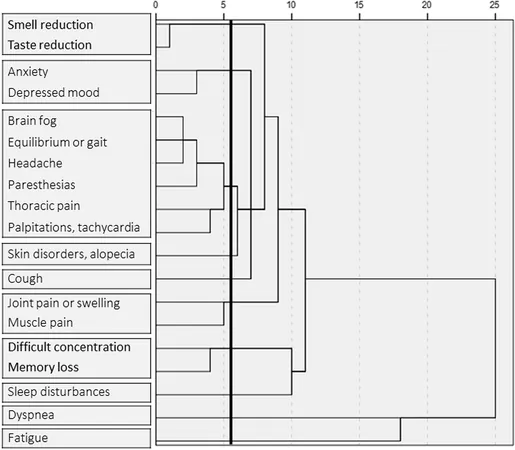
Groundbreaking Study Reveals Alarming Long-COVID Symptoms in a Diverse Patient Cohort of 1,297 Individuals
2024-11-14
Author: Wei
A comprehensive clinical study, part of Italy's ambitious project aimed at tackling the long-term effects of COVID-19—termed Long-COVID—has unveiled significant details regarding symptom profiles and demographic variations among patients. Funded by the National Centre for Disease Prevention and Control of the Italian Ministry of Health, this investigation, which started in January 2023 and wrapped up in March 2024, included 1,297 patients who displayed lingering symptoms at least four weeks following their initial SARS-CoV-2 infection.
Diving into the Data: A Diverse Patient Cohort
As of April 2, 2024, data from 1,910 patients retrieved from 30 clinical centers were logged, leading to the exclusion of 613 patients based on set eligibility criteria, resulting in the final analyzed cohort of 1,297 adults. Notably, a considerable 80.9% of symptom data was collected retrospectively, offering insights into symptoms reported after an average of 224 days following the initial infection.
The variances in demographics revealed intriguing trends. Generally, women in the cohort were younger and less likely to suffer from severe COVID-19 cases, a trend highlighted by fewer hospitalizations compared to their male counterparts. However, women reported a greater cumulative number of symptoms, indicating a potential paradox in resilience versus long-term debilitating effects.
The Long-COVID Symptom Landscape
On average, participants reported 3.4 symptoms each. This number skewed higher for women (3.6) compared to men (3.1), demonstrating a concerning trend where women showcased heightened vulnerability to Long-COVID symptoms like memory loss, cognitive difficulties, and various physical symptoms, including cough and tachycardia.
Strikingly, fatigue and dyspnea emerged as the leading symptoms, severely impacting patients' quality of life. Among younger patients (under 60), 23.8% experienced decreased working capability post-infection, underscoring the condition's significant socio-economic repercussions.
Clustering Symptoms: A New Perspective on Long-COVID
The study's clustering analysis unveiled intricate relationships between symptoms. For instance, cognitive dysfunction (memory and concentration issues) frequently coexisted with mood disturbances (anxiety and depression), whereas physical manifestations like joint pain were linked to sensory alterations in taste and smell. This granular analysis points towards distinct pathways that might inform targeted treatment options.
Implications of the Findings
In a notable outcome, researchers categorized patients into two distinct clusters based on demographic and clinical traits. The first cluster comprised younger, predominantly female patients who recovered from milder COVID-19 infections during the Omicron phase. In contrast, the second cluster involved older males suffering from more intense infections, mainly preceding the Omicron wave.
Despite the disparities in clinical characteristics, both clusters reported similar frequencies of reduced working activity, signaling a pervasive impact of Long-COVID irrespective of initial disease severity.
A Call to Action
This substantial study demonstrates the necessity for heightened awareness and resources dedicated to understanding Long-COVID, a condition that continues to pose challenges to public health and individual well-being. The findings not only highlight the urgent need for tailored treatment strategies but also emphasize the importance of addressing gender differences in symptom presentation and recovery trajectories.
As our understanding of Long-COVID evolves, continued research will be crucial in unraveling this complex syndrome, ensuring better management for those affected, and ultimately paving the way for policy recommendations. This study stands as a critical step in that direction, shedding light on a condition that remains shrouded in uncertainty.





 Brasil (PT)
Brasil (PT)
 Canada (EN)
Canada (EN)
 Chile (ES)
Chile (ES)
 Česko (CS)
Česko (CS)
 대한민국 (KO)
대한민국 (KO)
 España (ES)
España (ES)
 France (FR)
France (FR)
 Hong Kong (EN)
Hong Kong (EN)
 Italia (IT)
Italia (IT)
 日本 (JA)
日本 (JA)
 Magyarország (HU)
Magyarország (HU)
 Norge (NO)
Norge (NO)
 Polska (PL)
Polska (PL)
 Schweiz (DE)
Schweiz (DE)
 Singapore (EN)
Singapore (EN)
 Sverige (SV)
Sverige (SV)
 Suomi (FI)
Suomi (FI)
 Türkiye (TR)
Türkiye (TR)
 الإمارات العربية المتحدة (AR)
الإمارات العربية المتحدة (AR)